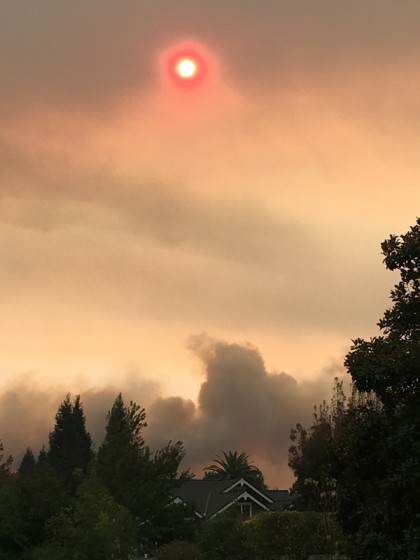The color of Mars, the color of blood, the color of sunlight through a sky filled with smoke, red on the Cal Fire map means the land is burning. Buddhist paintings depicting wrathful deities often show the figures surrounded by red flames. Though deities like “Mahakala” are fanged, many-armed, grimacing and colored black – what we customarily consider terrifying – the flames symbolize the warmth of compassion, and the terrifying visage is intended to crush the power of ego and its all-consuming nature of desire and attachment.
Fire too, is all-consuming. Like Mahakala, fire severs all attachment, or at least brings us face-to-face with what we hold most dear. In preparing to abandon home, my wife and I each confronted personal desires and attachment, selecting among a lifetime of items small enough to fit in a couple of cars: artwork, family photos, curios, documents, medications, jackets and a change of clothes. Left behind – the plants, family furniture, grandparent’s dishes, carpets, etc. – all potential sacrificial offerings to fire.
For the ancient Greeks, sacrificial offering was the essential daily practice. In this way, the relationship of humankind to the immortal gods was displayed. When animals were sacrificed, the edible portions were divided for human consumption and the remaining bones burned as an offering to the gods. The smoke, it was believed, was food for the gods, rising upwards into that realm only the gods controlled. Thus smoke was the conduit, the communication medium, the tangible link between heaven, earth and human activity.
For us moderns, such belief seems naive or childish, and yet the all-consuming fire feels god-like in its power and we rush to escape its grasp. Our own success at god-like power deceives us, and we lose sight of the power of natural forces we sometimes unleash.
Native Americans used fire to transform the landscape, and encourage the type of environment that sustained them. Their lives of non-industrial technology was earth-based, and replenished by the land itself. Fire helped the oaks produce more acorns, and opened land from the grip of cluttered ground-cover to create open grazing land for wildlife. With no cities to defend, living off the land, fire was an ally, not a foe.
Civilization and fire have an uneasy relationship. Our fixed cities mean we use fire when it’s to our advantage, but otherwise suppress it. Like any elemental force, however, fire resists suppression – in high-tension lines or tinder dry forest – and when conditions arise, its god-like power wipes the land clean, leaving only ash. That ash replenishes the soil, quietly leaching minerals back into the ground and replenishing its fertility. Absent human activity, life naturally retreats into the silence of the land.
But this knowledge does not salve the pain of human trauma and loss any more than death and destruction by hurricanes or tornadoes feels like spiritual purification; each of us must in some way come to terms with what has happened. As lives and the community are rebuilt, the process of rebuilding provides a deep source of contemplation. What do we want, what do we need? If we have to start over, do we want to replicate what we had before or instead reinvent our lives? Others have experienced the fires of destruction; what lessons did they learn?
The generosity and decency of this community feels wonderful, and there is a lesson in that. May the warm fire of compassion consume us.
